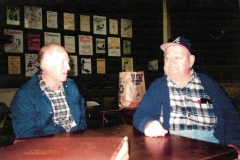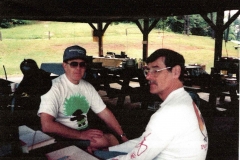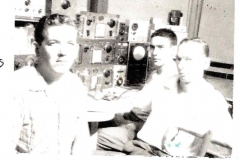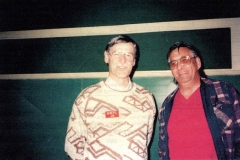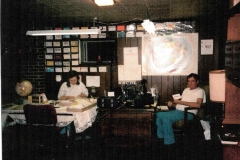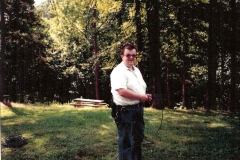This page is dedicated to AJARC (formerly known as the Greeneville Amateur Radio Club) members who are no longer with us. If you know of someone that was a club member and is not on the list, please contact AA4IM at ajarc1958@gmail.com.
James “Jim” Arrington K4EWE
Paul Basset KD4IMV SK
James M. “Pee Wee” Boles W4VUA SK
Dr. V. R “Doc” Bottomley K4UOA SK
Pete Bowman N1PB SK
Ed Bradley W4VGI SK
Oscar Bradley WA4LYF SK
Chester “Chet” Brent N4TV SK
Lon Brickley W4AFS SK
Robert “Bob” Britton WA4QZO SK
Herrick “Brownie” Brown W4ZZ SK
Ken Carter W4FEP SK
Wayne Collins AE4VC SK
Jack Creed K4EPC SK
Clarence L. “Lee” Crisp Sr W4ANB SK
Virginia Cutshaw KI4GLM SK
Howard Daniels W4ALT SK
Justin Devault W4XW SK
Howard “Wally” Dobson W4AJC (formerly WA4AJC) SK
Werner Dolder AA4IX (formerlyWB4CXL, HB9MJ) SK
Bill Duggan N4SEO (formerly K4MOU) SK
Nute Duggan W4VTI SK
Ray Elliott KD4IMW SK
Fred Fellers K4FVC SK
Ken Foster K4GHI SK
Gary Gammon KJ4C SK
Fred Gettings N4HVP SK
Mack Greene K4ARZ SK
Willard “Bill” Griffiths WB4WMR SK
Nancy Hale WD4FOA SK
Jack Harrell WA4BJU SK
Alvin Harrison KR4A SK
Frank Heinis K4JRJ SK
Robert “Burl” Honeycutt KB4VCH SK
Keith Hopson W4WWC SK
Nathaniel “Jonesy” Jones K8DJE SK
Paul “Butch” Johnson WA4LNS SK
John Mangognia WD9GUY SK
Issac Mathews KB4BBM SK
Glenn Ray McCurry (CALL UNKNOWN) SK
Bert McDaniel WD4PLH SK
Dan McLean K4TA (formerly WA4JTI) SK
Everette Moore WB4DPZ SK
Robert Morris N3ID SK
Dan Murphy KD4YUU
Leslie Ottinger K4VKK SK
Powell Potter WA4CHE SK
Forrest Pride WB4KEG SK
Robert “Bob” Rhea Jr N4SKX SK
Earl Dean Seaton K4NUM SK
Oland K Shrewsbury N4ZOO SK
Ernest Smith KD4IMU SK
James Stewart KE4KKI SK
David “Ken” Thompson WB4CEG SK
Don Turner WA4RFJ SK
Charles Waddle N4ZPG SK
Howard C. Wells WB4NZH SK
Herbert West N4BHS SK
John Woolsey WD4ALT SK
George Wrenn K4ZBF SK
James “Ty” Yokley W4LWC SK
Charles “Cliff” Kayhart W4KKP SK
Robert “Rob” Jordan N4RBJ SK
George Lemnah KG4MSH SK
Doyle Edmondson N4VV SK
Why Are Deceased Amateur Radio Operators Called “Silent Keys” ?
In the early days of radio Morse code was the only way to send and receive messages . A telegraph key was used to send the dots and dashes. Today some amateur operators use Morse code as it the one of the most dependable means of communicating when all other modes fail. This especially true if low power is used. Morse code transmissions are usually called CW which is an abbreviation for “Continuous Wave” tube transmitters that replaced the early spark gap transmitters. A CW transmitter is turned on and off in intervals to correspond with the Morse code dots and dashes. This sound this makes to the human ear is “dits” and “dahs” on a receiver.
The pro-sign “SK” or di-di-di-dah-di-dah” as it sounds over the radio is used to designate the last communication of the sending radio station’s transmissions with another station. When an amateur radio operator passes away his station has sent its last transmission therefore his telegraph (Morse code) key has gone silent.
What happens to the FCC Callsign after a ham passes away?
The FCC is supposed to be notified when an amateur passes away and their license will be canceled retroactive to the date they passed away. The callsign can be obtained by a family member, provided they meet the requirements for the class of license for that callsign block during the 2 year waiting period that follows a cancellation. After 2 years and 1 day, the license may be reissued to anyone that qualifies for the callsign that applies for it.
Sometimes the FCC is not notified and the callsign will show as active until the renewal date. After the renewal date, the license will show as expired and then the two year waiting period begins. You can submit documentation to the fcc If you know a ham has passed away. They will cancel the license retroactive to the day of death if it shows as active or expired. If it has been more than 2 years and 1 day since the license was canceled, this will release the callsign for immediate reassignment if you want to apply for it when it shows canceled in the database.
In theory you could submit evidence to the FCC that a licensee was deceased more than 2 years and one day and then submit a request for the callsign to be assigned to you and hope the 18 day waiting period is sufficient time for the FCC to cancel the call before your application is processed. This would give you an advantage. People watch for the desirable 1×2 and 2×1 callsigns to become available. There are usually a lot of applicants and the issuance is by a lottery system based on the earliest day of qualifying applications. If your submission date was before everyone elses, you are given first preference and assured of being assigned the callsign. However, if your application is processed before the call is canceled, you would be denied.
